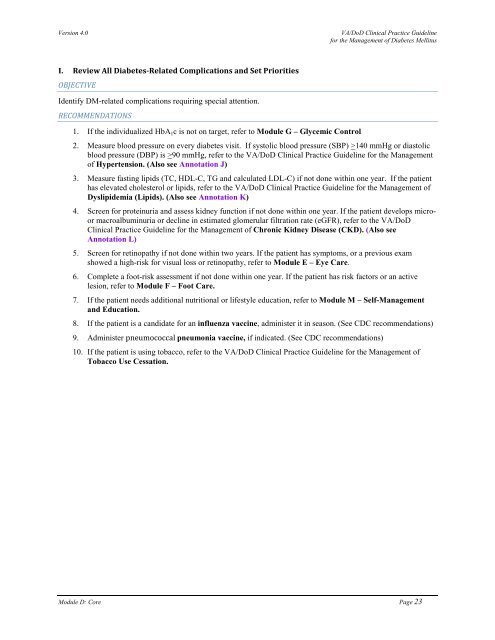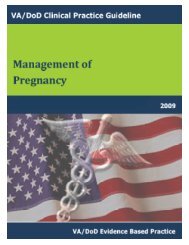DM Full Guideline (2010) - VA/DoD Clinical Practice Guidelines Home
DM Full Guideline (2010) - VA/DoD Clinical Practice Guidelines Home
DM Full Guideline (2010) - VA/DoD Clinical Practice Guidelines Home
Create successful ePaper yourself
Turn your PDF publications into a flip-book with our unique Google optimized e-Paper software.
Version 4.0<br />
<strong>VA</strong>/<strong>DoD</strong> <strong>Clinical</strong> <strong>Practice</strong> <strong>Guideline</strong><br />
for the Management of Diabetes Mellitus<br />
I. Review All Diabetes-Related Complications and Set Priorities<br />
OBJECTIVE<br />
Identify <strong>DM</strong>-related complications requiring special attention.<br />
RECOMMENDATIONS<br />
1. If the individualized HbA 1 c is not on target, refer to Module G – Glycemic Control<br />
2. Measure blood pressure on every diabetes visit. If systolic blood pressure (SBP) >140 mmHg or diastolic<br />
blood pressure (DBP) is >90 mmHg, refer to the <strong>VA</strong>/<strong>DoD</strong> <strong>Clinical</strong> <strong>Practice</strong> <strong>Guideline</strong> for the Management<br />
of Hypertension. (Also see Annotation J)<br />
3. Measure fasting lipids (TC, HDL-C, TG and calculated LDL-C) if not done within one year. If the patient<br />
has elevated cholesterol or lipids, refer to the <strong>VA</strong>/<strong>DoD</strong> <strong>Clinical</strong> <strong>Practice</strong> <strong>Guideline</strong> for the Management of<br />
Dyslipidemia (Lipids). (Also see Annotation K)<br />
4. Screen for proteinuria and assess kidney function if not done within one year. If the patient develops microor<br />
macroalbuminuria or decline in estimated glomerular filtration rate (eGFR), refer to the <strong>VA</strong>/<strong>DoD</strong><br />
<strong>Clinical</strong> <strong>Practice</strong> <strong>Guideline</strong> for the Management of Chronic Kidney Disease (CKD). (Also see<br />
Annotation L)<br />
5. Screen for retinopathy if not done within two years. If the patient has symptoms, or a previous exam<br />
showed a high-risk for visual loss or retinopathy, refer to Module E – Eye Care.<br />
6. Complete a foot-risk assessment if not done within one year. If the patient has risk factors or an active<br />
lesion, refer to Module F – Foot Care.<br />
7. If the patient needs additional nutritional or lifestyle education, refer to Module M – Self-Management<br />
and Education.<br />
8. If the patient is a candidate for an influenza vaccine, administer it in season. (See CDC recommendations)<br />
9. Administer pneumococcal pneumonia vaccine, if indicated. (See CDC recommendations)<br />
10. If the patient is using tobacco, refer to the <strong>VA</strong>/<strong>DoD</strong> <strong>Clinical</strong> <strong>Practice</strong> <strong>Guideline</strong> for the Management of<br />
Tobacco Use Cessation.<br />
Module D: Core Page 23
















